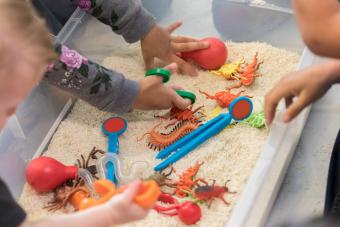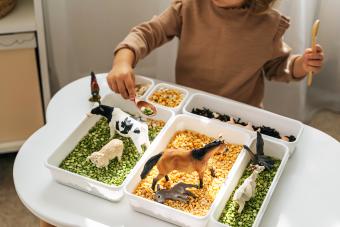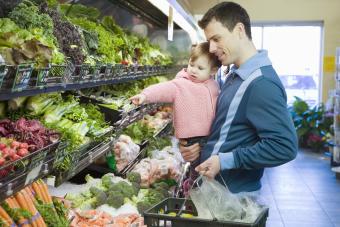
Are you looking for engaging and educational play experiences for your child? Sensory bins are a fantastic option for building fine and gross motor skills, fostering language development, and they even have a convenient calming effect on your child!
How can you make these extraordinary exploration spaces? It's actually a lot easier than you would think. We break down what you need to create your own DIY sensory bins for toddlers.
Sensory Bin Fillers That Inspire & Delight Kids
The difference between a simple container filled with toys - and a sensory bin - is the filler. When deciding on a material to use, consider the age of the children playing in the bin. For babies and toddlers, some fillers can pose a choking hazard or can find their way up tiny nostrils.
Be mindful about bin contents and the developmental stages of your kids too. Never use sensory bin objects that can prove dangerous for children. Also, consider the level of mess that you'll have to clean up. Kids love liquids, but they can bring extra work for parents when these activities are enjoyed indoors.

Common Sensory Bin Fillers:
- Rice, peas, or beans
- Corn, oats, or wheat
- Dried pasta
- Plastic beads or water beads
- Kinetic sand or cloud dough
- Dirt or sand
- Birdseed
- Pebbles or aquarium rocks
- Easter grass
- Water
- Shaving Cream
- Oobleck (cornstarch and water)
Up the ante and add glitter to the shaving cream, dye their rice in different colors, and mix various fillers together to provide a unique feel. Or, purchase pasta in an array of shapes and beans in different sizes. These can give kids the opportunity to sort and sift these materials.
Sensory Bin Scoops and Tools
Most sensory bins for toddlers include scooping and dumping mechanisms that allow children to explore the filler and the other objects within the space. These tools aid in developing a child's fine motor skills. Common ideas for sensory bin tools include:

- Measuring Cups
- Measuring Spoons
- Stackable Cups
- Funnels
- Small tupperware containers (in different sizes)
- Shovels
- Spoons
- Paintbrushes
- Tweezers
- Tongs
- Silicone molds
- Sieves
- Whisks
- Cookie Cutters
- Magnets
- Toothbrushes
- Small plastic watering cans
- Dump truck, excavator, and bulldozer toys
Inventive Sensory Bin Object Ideas
This is where the fun and creativity comes into play. Add small objects into your bin so that your children have items to discover and play with in the space. You can choose to place several random objects into the bin, so kids must consider the different ways to use them, or you can design a theme for your bin using the objects you choose to add to it. Kids love creating scenes with small dinosaurs, animals, and plastic bugs!
Matchbox Cars
Race matchbox cars over sand hills or through rocky dirt piles. Sink a Tupperware container full of water into the dirt and have the cars splash through the mud.
Ice Cubes
If you have a water table, toss in some ice cubes! For added fun, make ice cubes with small objects frozen into them. Kids can watch the ice melt in the water as the frozen objects are freed.
Faux Gems
Make a sensory table that sparkles! Add glitter to the filler (if you are brave enough for glitter to fly about in your home) and add dazzling faux gemstones to your bin.
Small Letters and Numbers
Add small letters and numbers to bins for guided learning activities. Have kids dig around the bin and pull out a letter or number. Ask them what the letter or number is. Can they think of a word that starts with the letter? Can they count up to the number they pulled from the filler?
Seashells
Shells of different sizes and shapes are great additions to a beachy bin full of sand, shovels, and small, plastic ocean animals.
Small Blocks
Toss blocks into a bin and see what kids can create with them. Use blocks of different colors and shapes and combine wooden and plastic blocks for varying tactile feels.
LEGO Bricks
LEGO bricks are great additions to a bin. Toss a bunch into a bin and let kids build away.
Creative Sensory Bin Theme Ideas
You might choose to create a theme using your sensory bin too. Seasonal and educational themes are common ideas for sensory bins, but you can also go with global themes like the ocean, space, farmyards, or anything that would interest your child.
Remember that these ideas can be used for any age group as long as you modify the fillers. Beans, beads, and pebbles can be choking hazards so these materials should be avoided if the sensory bin is for a toddler. If your child is prone to putting things in their mouths, also consider using non-toxic options like edible sand, oats, or water.
Land Before Time Dinosaur Bin
This dinosaur sensory bin can be a great mix of both liquid and solid fillers. Use sand for the land and then submerge a shallow tupperware container filled with water in the space. Add in dinosaur toys, twigs, rocks, and fake leaves. Give your kids small shovels and paintbrushes and let them dig for dinosaurs!

To Infinity and Beyond
Black beans are a great backdrop for your a space themed sensory bin! Add in star and planet toys, astronauts and aliens, and tweezers to pluck the stars and planets from the sky.
Under the Sea Sensory Bin Idea
For ocean themed fun, grab some plastic saltwater creatures, shells, a plastic treasure chest, and plastic gold coins. Fill the bottom of the bin with aquarium rocks and then submerge your sea scene in water! Give your kids tweezers, a small net, and even goggles to allow them to explore this underwater world.
Old MacDonald Theme
This farm bin can be a smorgasbord of sensory fun! Have black beans for the pigpen, corn for the barnyard, and green rice for the pasture. Put all types of farm animals in the space, along with a tractor, wheelbarrow, and shovel. Make sure that your little ranchers have small buckets for their cornmeal so that they can feed their animals.

End of the Rainbow
For the weather nerds in your life, consider making a rainbow sensory bin! You can dye rice in all the shades of the rainbow, add in brightly colored objects, and place cotton balls at the end of this arch for your clouds. Don't forget to include containers in various shades and tweezers so that your kids can sort the colored objects they find.
Winter Wonderland Idea
You can make fake snow for a filler or use water, glitter, and ice cubes in your bin. Toss in turned-over Tupperware containers and small Arctic animals so kids can explore a wintry scene.
Springtime and Easter Themes
Faux moss, crinkle grass, small eggs, and faux flowers all have a space in a springtime or Easter-themed bin. Hide eggs in the filler material and send kids on a little Easter egg hunt!
Sensory Junglescape
Dried peas make for a perfect jungle floor in your bin. Add plastic trees, faux boulders and moss, and jungle animals to set the scene.
Construction Zone
Dirt, kinetic sand, small rocks, and dump trucks will keep kids busy for hours. They can excavate their construction site and get the land ready for the new building. Add in LEGOs so that they can craft this metropolitan project.
Car Wash Bin
Parents can also create a car wash sensory bin with foaming bubble bath or shaving cream, sponges and scrub brushes, toy cars, and water filled spray bottles! This is a great outdoor option that is both messy and clean at the same time.
Literacy and Math Learning Bins
Learning is so much more fun when it takes place inside a sensory bin. Use plastic numbers and letters to create math and literacy lessons as kids dig through the filler materials.
Beach Bin Fun
Use sand, shovels, seashells, small marbles (to emulate beach balls), and a sunken bucket of water to make a beach-themed sensory bin for kids to hang ten in.
Setting Up Your Sensory Bin
Sensory bins are easy to create in your home, as long as you have a large, leakproof container, plenty of patience for possible messes, and materials for kids to manipulate and experience with their hands.
Designate a Spot
First, decide where you want to keep your bin. If you're going to be adding liquids, foams, or items that involve food coloring, be sure to put the bin on a hard and easy-to-clean floor surface, on the back patio, or in the garage. You might also want to set out a tarp underneath your bin to better catch the items that fall from the bin to the floor.
Choose the Right Bin
Next, consider the bin itself. It's common to use a large shallow, clear Tupperware or plastic tub to house sensory bin items. The great thing about this type of sensory bin is that once play is done for the day, you can pop a top on it and store it away for next time.
You can also use water tables as a sensory space. These elevated play spaces put everything at your child's fingertips! Best of all, these make for very versatile sensory bins. Fill them with water and objects for your kids to play with and then drain and dry the space and create a new dry landscape to explore.
Set Up on a Solid Table
Lastly, you'll want to choose a sensory table that is not breakable or easily tipped over. Imagine the contents of a sensory bin crashing onto the living room floor and spilling everywhere! If you have several children who will want to play at the table, be sure to use a large enough bin for everyone to play in the space.

Sensory Bins Offer Kids Tiny New Worlds to Explore
Sensory bins are great fun for all children. They enable kids to use their senses to explore objects around them, use their imagination and creativity, and fine tune their social skills and fine motor skills. Help your kids learn and have fun in these amazing little worlds!







